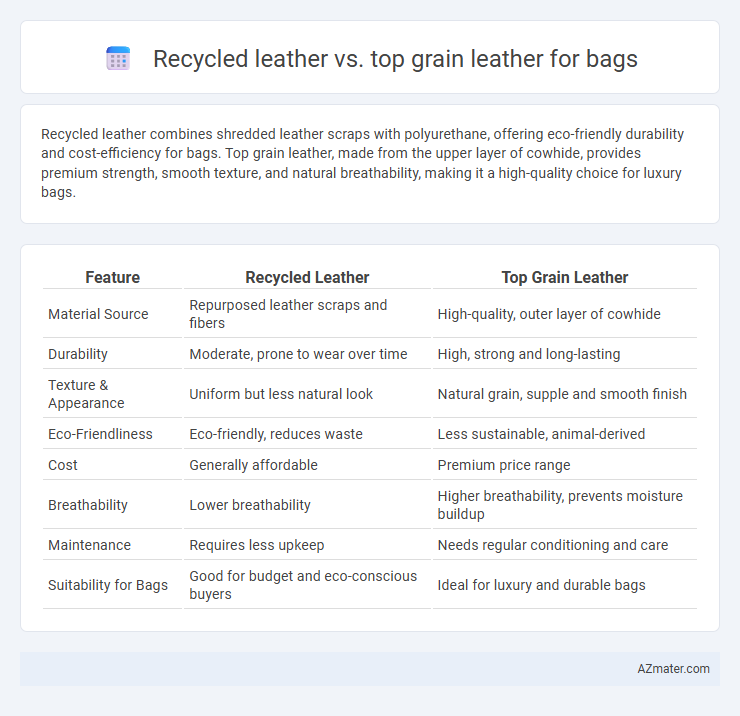Recycled leather combines shredded leather scraps with polyurethane, offering eco-friendly durability and cost-efficiency for bags. Top grain leather, made from the upper layer of cowhide, provides premium strength, smooth texture, and natural breathability, making it a high-quality choice for luxury bags.
Table of Comparison
| Feature | Recycled Leather | Top Grain Leather |
|---|---|---|
| Material Source | Repurposed leather scraps and fibers | High-quality, outer layer of cowhide |
| Durability | Moderate, prone to wear over time | High, strong and long-lasting |
| Texture & Appearance | Uniform but less natural look | Natural grain, supple and smooth finish |
| Eco-Friendliness | Eco-friendly, reduces waste | Less sustainable, animal-derived |
| Cost | Generally affordable | Premium price range |
| Breathability | Lower breathability | Higher breathability, prevents moisture buildup |
| Maintenance | Requires less upkeep | Needs regular conditioning and care |
| Suitability for Bags | Good for budget and eco-conscious buyers | Ideal for luxury and durable bags |
Introduction to Recycled Leather and Top Grain Leather
Recycled leather is made by processing leather scraps and fibers, combining them with binders to create an eco-friendly material that mimics the look and feel of genuine leather. Top grain leather is derived from the outermost layer of the hide, known for its durability and smooth surface, often used in premium bags for its high quality. Choosing between recycled leather and top grain leather depends on balancing sustainability with traditional luxury and durability standards.
Understanding the Production Processes
Recycled leather is made by shredding and bonding leather scraps with polyurethane or latex, creating an eco-friendly material with reduced waste and lower environmental impact. Top grain leather is crafted from the outer layer of the hide, undergoing processes like sanding and dyeing to preserve durability and natural texture for premium quality. The production of top grain leather requires more raw material and energy compared to recycled leather, but it offers greater strength and longevity for bags.
Environmental Impact: Sustainability Compared
Recycled leather significantly reduces waste by repurposing existing leather scraps and minimizing the need for new raw materials, thus lowering the environmental footprint associated with leather production. Top grain leather, while durable and high-quality, involves extensive resource consumption, including water, energy, and chemicals, contributing to deforestation and pollution. Choosing recycled leather for bags supports sustainability by promoting circular economy practices and reducing landfill contributions compared to conventional top grain leather manufacturing.
Texture, Appearance, and Aesthetic Differences
Recycled leather features a more uniform texture with slight grain inconsistency due to its composite manufacturing process, while top grain leather offers a naturally smooth and supple surface with visible grain patterns that reflect high quality. Appearance-wise, recycled leather tends to have a matte finish with limited aging potential, contrasting with the rich patina and vibrant hues of top grain leather that enhance over time. Aesthetically, top grain leather bags exhibit luxurious authenticity and depth, whereas recycled leather bags provide a more affordable, eco-friendly alternative with less natural variation.
Durability and Longevity
Top grain leather offers superior durability and longevity due to its dense fiber structure and natural resistance to wear, making it ideal for high-quality bags that withstand daily use. Recycled leather, composed of shredded leather fibers bonded with polyurethane or latex, tends to be less durable and may degrade faster under stress, resulting in shorter lifespan for bags. Choosing top grain leather ensures better aging characteristics and sustained strength over time compared to recycled leather alternatives.
Cost Comparison: Which Is More Affordable?
Recycled leather is generally more affordable than top grain leather due to lower production costs and the use of leather scraps bonded with polyurethane or latex. Top grain leather involves a more expensive process of selecting and treating the upper layer of hide, which increases its price significantly. For budget-conscious buyers seeking durability and aesthetic appeal, recycled leather offers a cost-effective alternative without the premium price tag of top grain leather.
Performance in Daily Use
Top grain leather offers superior durability and ages gracefully, making it ideal for daily use bags that require long-lasting performance and resistance to wear. Recycled leather, while eco-friendly and cost-effective, tends to be less durable and may show signs of cracking or peeling over time with frequent use. For daily use, top grain leather provides stronger structural integrity and better moisture resistance, ensuring the bag maintains its appearance and functionality longer.
Maintenance and Care Requirements
Top grain leather bags require regular conditioning to maintain softness and prevent cracking, benefiting from occasional cleaning with a damp cloth and leather-specific products to retain durability and appearance. Recycled leather bags demand gentle cleaning with mild soap solutions and must avoid excessive moisture or heat to prevent deterioration since the material lacks the natural durability of top grain leather. Proper storage in a cool, dry place away from direct sunlight is essential for both types to extend bag lifespan and preserve aesthetic quality.
Ethical Considerations and Consumer Preferences
Recycled leather offers a sustainable alternative to top grain leather by reducing waste and minimizing environmental impact, appealing to eco-conscious consumers seeking ethical fashion choices. Top grain leather remains favored for its durability and premium quality, often associated with luxury and longevity, though concerns over animal welfare influence some buyers to opt for recycled options. Consumer preferences increasingly lean toward transparency and ethical sourcing, driving demand for products that balance craftsmanship with sustainability in the bag market.
Which Leather Is Best for Bags? Conclusion
Top grain leather offers superior durability, natural texture, and aging qualities, making it the best choice for long-lasting, high-quality bags. Recycled leather provides an eco-friendly alternative but often lacks the strength and premium appearance of top grain leather. For bags requiring a combination of luxury and durability, top grain leather is the optimal material.

Infographic: Recycled leather vs Top grain leather for Bag
 azmater.com
azmater.com